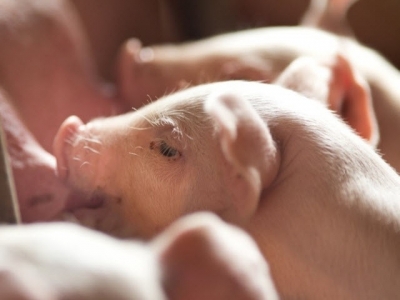Can better sow nutrition lead to better progeny?

Novus has been exploring the role of trace minerals in maternal nutrition through the use of epigenetics on development of piglets.
Photo: © GettyImages/Jevtic
Feeding the mother chelated trace minerals can exponentially have an effect on the progeny through the modulation of embryo gene expression, said Dr Mercedes Vazquez-Anon, senior director of animal nutrition and facilities at Novus.
A consultant carried out field work in Spain on behalf of Novus, using 80 swine herds, over a period of two years: “We are just collating the data now but we see the same results that we found in the US where we had a 9% improvement in piglet birthweight from replacing inorganic trace minerals with chelated Mintrex trace minerals in sow feed.”
The researchers saw the piglets coming from the sows fed those products had better carcass quality, said Dr Vazquez-Anon.
She presented on the trace mineral research at the 2018 Iberoamerican Swine Nutrition Roundtable in Spain, an event hosted by Novus earlier this month. We caught up with her to hear more.

Epigenetics explained
Prolific sows
Consultant nutritionists from Latin America and Europe spoke about industry challenges at that forum; one issue that dominated was sow productivity, how the newly developed genetic lines result in high prolific sows with increasing litter sizes, but how that production trend can sometimes come with a cost, the challenge is keeping the piglets alive.
“We see the larger litter size can negatively affect birthweight and litter uniformity, you have smaller piglets that sometimes won’t make it to the weaning phase, or, after weaning, they might always be the ones that are behind, so they are not expressing their full potential,” said Vazquez-Anon.
Rate of retention
The rate of retention of sows in the herd, in global production, also proved a major talking point at the event, she said.
“The two topics are areas that Novus has identified for a while – trying to understand how can we enhance the nutrition of the mother so that we can improve not only the profitability of the sow but also the quality of the litter.
“So this is what made us look at some of the long term studies that we have done over the years on chelated trace minerals in the form of Mintrex. Through observations in the field, we were seeing an increase in productivity of the sow in terms of retention, development of the skeleton of the sow, and reduced culling rates due to locomotion or lameness.”
“We had confirmation of healthier skeleton due to the fact that trace mineral nutrition improves the development and ossification of the bones and the joints.
“What we are also finding, though, was that feeding chelated minerals during lactation and gestation reduced variation in the weight of the piglets and increased their birthweight. So we started digging into it, trying to determine how this happened, using gene expression and epigenetics,” said the Novus animal nutrition lead.

US trends in average litter size
Epigenetics and fetal programing
Novus now has a better understanding of epigenetics in swine production, that by feeding the mother you can affect the performance of the progeny, she continued.
“By feeding Mintrex trace minerals we are modulating the expression of the genes involved in gut development, immunity, and muscle development which would help the piglet survive the process of weaning.
“We are learning how to best feed the sow to help her fulfill its genetic potential and, at the same time, improve the development of the progeny to enable the piglets fulfill their genetic potential.”
She said Novus is continuing to analyze the data.
“The epigenetics and gene modulation work in sows is still on going, we are substantiating it by combining basic with applied research to help us understand the mode of action and value of chelated mineral nutrition.”
Growing the gilt
The company is also carrying out work to develop the gilt.
“Perhaps one of the opportunities is for the sow to improve its skeleton capacity to grow the larger litters.
“Globally, there is a very low retention of the sow in the herd – maybe they don’t get pregnant, they have locomotion problems, they walk with difficulty and then they get culled. Nowadays, it is good news if the sow makes it beyond the third parity So we are looking at the development of the gilt to enable the sow hold the bigger litter and improve longevity.”
The company, relying on biomarkers, is exploring the role of zinc, manganese, and copper, phosphorous and calcium in the development of the cartilage matrix and ossification of the bone to improve bone strength.
Có thể bạn quan tâm
Phần mềm

Phối trộn thức ăn chăn nuôi

Pha dung dịch thủy canh

Định mức cho tôm ăn

Phối trộn phân bón NPK

Xác định tỷ lệ tôm sống

Chuyển đổi đơn vị phân bón

Xác định công suất sục khí

Chuyển đổi đơn vị tôm

Tính diện tích nhà kính

Tính thể tích ao hồ



 Pigs digest fiber efficiently even at high inclusion…
Pigs digest fiber efficiently even at high inclusion…  Pig nutrition welfare is gaining ground in EU
Pig nutrition welfare is gaining ground in EU